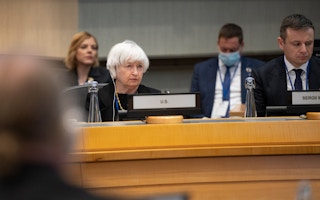When United States Secretary of the Treasury Henry Morgenthau opened the Bretton Woods Conference almost 80 years ago, he reminded delegates that failures of international cooperation had led to the Great Depression, social division, and ultimately war.
“Prosperity, like peace, is indivisible,” he concluded. “We cannot afford to have it scattered here or there among the fortunate…Poverty, wherever it exists, is menacing to us all.”
That message speaks across the ages. We are again facing global challenges that can be met only through international cooperation. Large swaths of the developing world are being excluded from global prosperity. Extreme poverty is rising. Hard-won gains in health, education and nutrition are under threat. Already obscene economic inequalities between and within countries are widening. The window of opportunity for averting a climate catastrophe is about to slam shut. And yet multilateral cooperation is paralysed by complacency, petty rivalries and inward-looking nationalism.
Consider this year’s International Monetary Fund and World Bank Spring Meetings, which offered an opportunity to mobilise the finance needed to prevent wholesale reversals of progress toward the 2030 Sustainable Development Goals (SDGs). Instead, Western governments and the G20 arrived with no shared agenda, spent a week swapping platitudes, and left the world with a set of vague and incoherent declarations.
We cannot afford leadership failures on this scale. The IMF and the World Bank, the twin pillars of the Bretton Woods system, should be at the heart of international cooperation in responding to the defining challenges facing our generation, starting with the two-tier recovery from the economic downturn triggered by COVID-19.
Unlike advanced economies, which have recovered on the back of vast government financing and vaccination programs, many developing economies have suffered deep scarring. Growth has slowed, tax revenues have fallen, and two-thirds of low-income countries are either in or at risk of debt distress. The IMF estimates that the poorest countries will need an additional $450 billion to return to their pre-pandemic development trajectories.
Budget pressures are limiting governments’ capacity to defend human development gains. The pandemic pushed almost 100 million people into extreme poverty. That figure is set to rise as safety nets are cut and Russia’s war in Ukraine fuels food-price inflation, raising the specter of increased malnutrition, or even famine, in some parts of the world. More than 40 of the poorest countries are spending more servicing their debts than on public health. Education budgets are being cut even as millions of the world’s most disadvantaged children return to classrooms carrying the learning losses inflicted during pandemic-related school closures.
Against this grim backdrop, international cooperation to finance an “SDG recovery” has gained new urgency. The OECD estimates that the already-large pre-pandemic SDG financing gap has increased by $1.2 trillion. That’s without the incremental investments of $2 trillion annually needed to support renewable-energy investments in developing countries to achieve the 2015 Paris climate agreement’s goals.
When governments committed to the SDG agenda seven years ago, they pledged a bold new approach to development finance that would convert “billions into trillions.” The architects of the Bretton Woods system created the vehicle to do so in the form of multilateral development banks (MDBs).
Designed to support postwar European reconstruction, the MDB system – the World Bank and its regional counterparts – enshrines a simple but powerful financial model. With small amounts of paid-in capital underpinned by much larger government guarantees (“callable capital”), the MDBs can use their AAA credit ratings to issue bonds at low interest rates and lend to developing countries, effectively mobilising private finance for public investment. The World Bank, the largest MDB, has only $19 billion of paid-in capital, and $278 billion of callable capital.
Multilateral finance has multiplier effects that bilateral aid cannot duplicate. Every $1 invested in the World Bank through paid-in capital mobilizes $4 in new finance. Yet the MDB system is at best weakly exploited. Apart from its soft-loan facility, the International Development Association, the World Bank system played a muted role in supporting developing countries during the pandemic, and the MDBs’ financing portfolio for climate interventions in low- and middle-income countries is just $38 billion – a fraction of what is needed.
While the MDBs (notably the African Development Bank) are undercapitalised, the bigger problem is a deeply entrenched conservatism in financial governance. Major shareholders – the US and European governments – refuse to allow callable-capital guarantees to be integrated into lending operations. Researchers at the Overseas Development Institute estimate that changing this rule could mobilise an additional $1.3 trillion, with only a marginal change in credit ratings and borrowing costs.
Speaking at the spring meetings, US Secretary of the Treasury Janet Yellen lamented the MDBs’ failure to mobilise the trillions needed for pandemic recovery. And yet the Biden administration has failed to overhaul the rules on callable capital.
Other attempts at innovation have run into a bureaucratic brick wall. Gordon Brown, the United Nation’s Special Envoy for Global Education, has proposed a system of modest grants and guarantees that could double MDB financing for education, unlocking $10 billion. Yet even in the face of an unprecedented education crisis, donors have failed to act.
This is a travesty of the Bretton Woods system. In the misplaced defense of AAA credit ratings, the MDBs are eschewing solutions that would support recovery, prevent devastating reversals in human development, and bring hope to millions of children.
Sadly, it is not just the MDB agenda that is stuck. Nine months after G20 governments pledged to allocate $100 billion of the IMF’s new issuance of special drawing rights (SDRs, the Fund’s reserve asset) to poor countries, not a single cent has been transferred. Meanwhile, with debt servicing set to surge by 45% this year – most of it going to commercial creditors and China – vital investments are being crowded out, and the risk of disorderly sovereign defaults is growing. Yet we are no closer to a comprehensive debt-reduction framework than we were a year ago.
As the crisis triggered by COVID-19 has deepened, some commentators have called for a new Bretton Woods system. They have a point. The World Bank and the IMF maintain anachronistic Western-dominated governance systems. But what is missing from the response to today’s defining human development challenges is not financial architecture, but rather the sense of urgency, shared purpose, and common endeavor that defined the original Bretton Woods conference.
Kevin Watkins, a former CEO of Save the Children UK, is a visiting professor at the Firoz Lalji Institute for Africa at the London School of Economics.
Copyright: Project Syndicate, 2022.











